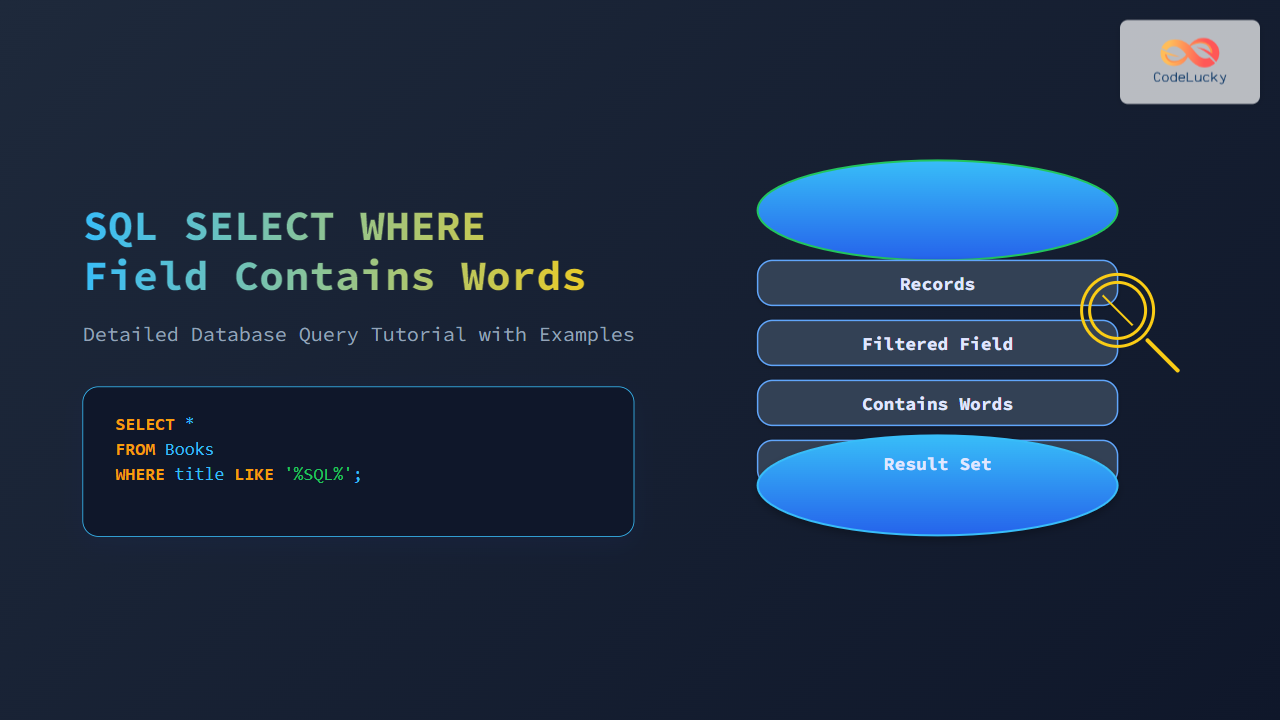In the world of relational databases, data is often spread across multiple tables. While this approach helps maintain data integrity and reduces redundancy, it also necessitates a way to establish relationships between these tables. Enter the SQL FOREIGN KEY constraint – a powerful tool that allows us to link tables and create meaningful connections between related data.
Understanding the FOREIGN KEY Constraint
A FOREIGN KEY is a column (or a combination of columns) in one table that refers to the PRIMARY KEY in another table. It acts as a cross-reference between tables, establishing a link based on the values in these columns.
🔑 Key Points:
- A FOREIGN KEY creates a relationship between two tables.
- It refers to the PRIMARY KEY of another table.
- It maintains referential integrity in the database.
Let's dive deeper into how FOREIGN KEYs work and explore their implementation with practical examples.
Creating Tables with FOREIGN KEY Constraints
To understand FOREIGN KEYs better, let's create two related tables: Departments and Employees.
CREATE TABLE Departments (
DepartmentID INT PRIMARY KEY,
DepartmentName VARCHAR(50) NOT NULL
);
CREATE TABLE Employees (
EmployeeID INT PRIMARY KEY,
FirstName VARCHAR(50) NOT NULL,
LastName VARCHAR(50) NOT NULL,
DepartmentID INT,
FOREIGN KEY (DepartmentID) REFERENCES Departments(DepartmentID)
);
In this example, the Employees table has a FOREIGN KEY DepartmentID that references the DepartmentID in the Departments table. This establishes a relationship where each employee belongs to a department.
Inserting Data with FOREIGN KEY Constraints
When working with tables linked by a FOREIGN KEY, we need to be mindful of the order in which we insert data. Let's populate our tables:
-- Insert data into Departments table
INSERT INTO Departments (DepartmentID, DepartmentName) VALUES
(1, 'Human Resources'),
(2, 'Marketing'),
(3, 'IT');
-- Insert data into Employees table
INSERT INTO Employees (EmployeeID, FirstName, LastName, DepartmentID) VALUES
(101, 'John', 'Doe', 1),
(102, 'Jane', 'Smith', 2),
(103, 'Mike', 'Johnson', 3),
(104, 'Emily', 'Brown', 1);
Notice that we first insert data into the Departments table before inserting into the Employees table. This is because the FOREIGN KEY constraint requires that the referenced value (in this case, DepartmentID) must exist in the parent table (Departments) before it can be used in the child table (Employees).
Querying Data with FOREIGN KEY Relationships
One of the main advantages of using FOREIGN KEYs is the ability to join tables and retrieve related data efficiently. Let's look at some examples:
Example 1: Basic JOIN Query
SELECT e.EmployeeID, e.FirstName, e.LastName, d.DepartmentName
FROM Employees e
JOIN Departments d ON e.DepartmentID = d.DepartmentID;
This query will return:
| EmployeeID | FirstName | LastName | DepartmentName |
|---|---|---|---|
| 101 | John | Doe | Human Resources |
| 102 | Jane | Smith | Marketing |
| 103 | Mike | Johnson | IT |
| 104 | Emily | Brown | Human Resources |
This JOIN operation allows us to see which department each employee belongs to, demonstrating the power of the FOREIGN KEY relationship.
Example 2: Counting Employees per Department
SELECT d.DepartmentName, COUNT(e.EmployeeID) AS EmployeeCount
FROM Departments d
LEFT JOIN Employees e ON d.DepartmentID = e.DepartmentID
GROUP BY d.DepartmentName;
This query will return:
| DepartmentName | EmployeeCount |
|---|---|
| Human Resources | 2 |
| Marketing | 1 |
| IT | 1 |
Here, we use a LEFT JOIN to ensure all departments are included, even if they have no employees. The COUNT function gives us the number of employees in each department.
Updating and Deleting with FOREIGN KEY Constraints
FOREIGN KEY constraints also affect how we can update or delete data in our tables.
Updating Referenced Values
Let's try to update a department ID in the Departments table:
UPDATE Departments
SET DepartmentID = 4
WHERE DepartmentID = 1;
This query will fail because the DepartmentID 1 is referenced by records in the Employees table. The FOREIGN KEY constraint prevents us from changing or deleting values that are referenced by other tables.
Deleting Referenced Records
Similarly, trying to delete a department that has employees will fail:
DELETE FROM Departments
WHERE DepartmentID = 2;
This query will not execute successfully because there's an employee (Jane Smith) in the Marketing department.
ON DELETE and ON UPDATE Clauses
To handle these situations, we can use ON DELETE and ON UPDATE clauses when defining our FOREIGN KEY constraints. Let's modify our Employees table to include these:
CREATE TABLE Employees (
EmployeeID INT PRIMARY KEY,
FirstName VARCHAR(50) NOT NULL,
LastName VARCHAR(50) NOT NULL,
DepartmentID INT,
FOREIGN KEY (DepartmentID) REFERENCES Departments(DepartmentID)
ON DELETE SET NULL
ON UPDATE CASCADE
);
Now, let's see how these clauses affect our operations:
ON DELETE SET NULL
If we delete a department, the DepartmentID for all employees in that department will be set to NULL:
DELETE FROM Departments WHERE DepartmentID = 2;
After this operation, Jane Smith's DepartmentID will be NULL.
ON UPDATE CASCADE
If we update a DepartmentID in the Departments table, the change will cascade to the Employees table:
UPDATE Departments
SET DepartmentID = 4
WHERE DepartmentID = 3;
This will update Mike Johnson's DepartmentID from 3 to 4 automatically.
Best Practices for Using FOREIGN KEYs
🌟 Here are some best practices to keep in mind when working with FOREIGN KEYs:
- Always define FOREIGN KEYs on columns that reference PRIMARY KEYs or UNIQUE constraints in other tables.
- Use meaningful names for your FOREIGN KEY constraints to improve database documentation.
- Consider the impact of ON DELETE and ON UPDATE clauses carefully – choose the option that best fits your data integrity requirements.
- Index FOREIGN KEY columns to improve query performance, especially for JOIN operations.
- Be mindful of the order of operations when inserting or deleting data across related tables.
Advanced FOREIGN KEY Concepts
Composite FOREIGN KEYs
Sometimes, a relationship between tables might involve multiple columns. In such cases, we can create a composite FOREIGN KEY. Here's an example:
CREATE TABLE Orders (
OrderID INT,
ProductID INT,
Quantity INT,
PRIMARY KEY (OrderID, ProductID),
FOREIGN KEY (ProductID) REFERENCES Products(ProductID)
);
CREATE TABLE OrderDetails (
OrderID INT,
ProductID INT,
ShipDate DATE,
FOREIGN KEY (OrderID, ProductID) REFERENCES Orders(OrderID, ProductID)
);
In this example, OrderDetails has a composite FOREIGN KEY that references both OrderID and ProductID in the Orders table.
Self-Referencing FOREIGN KEYs
A table can have a FOREIGN KEY that references its own PRIMARY KEY. This is useful for hierarchical data structures, like an employee hierarchy:
CREATE TABLE Employees (
EmployeeID INT PRIMARY KEY,
FirstName VARCHAR(50),
LastName VARCHAR(50),
ManagerID INT,
FOREIGN KEY (ManagerID) REFERENCES Employees(EmployeeID)
);
Here, the ManagerID is a FOREIGN KEY that references the EmployeeID in the same table, allowing us to represent a management hierarchy.
Conclusion
FOREIGN KEYs are a fundamental concept in relational databases, providing a mechanism to enforce referential integrity and establish relationships between tables. By understanding how to create, use, and manage FOREIGN KEYs, you can design more robust and efficient database schemas.
Remember, while FOREIGN KEYs offer many benefits, they also come with responsibilities. Always consider the impact of FOREIGN KEY constraints on your data operations and choose the appropriate ON DELETE and ON UPDATE actions to maintain data integrity.
As you continue to work with databases, you'll find that mastering FOREIGN KEYs opens up new possibilities for data modeling and querying, allowing you to create more sophisticated and powerful database applications.
- Understanding the FOREIGN KEY Constraint
- Creating Tables with FOREIGN KEY Constraints
- Inserting Data with FOREIGN KEY Constraints
- Querying Data with FOREIGN KEY Relationships
- Updating and Deleting with FOREIGN KEY Constraints
- ON DELETE and ON UPDATE Clauses
- Best Practices for Using FOREIGN KEYs
- Advanced FOREIGN KEY Concepts
- Conclusion



















